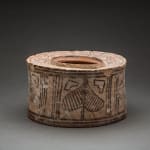Pottery Canister Painted with Pipal Leaf Design, 2800 BCE - 2600 BCE
fired clay
10.2 x 17.8 cm
4 x 7 in
4 x 7 in
LO.577
Further images
Short cylindrical body, short neck with a wide rim, the sides painted with compartmented sauqres enclosing a pipal leaf. This type of fired clay vessel was mostly produced at the...
Short cylindrical body, short neck with a wide rim, the sides painted with compartmented sauqres enclosing a pipal leaf.
This type of fired clay vessel was mostly produced at the site of Merhgarh in Baluchistan. From here and other small centres, they were traded far and wide throughout Baluchistan, from the borders of the Indus Valley to south-eastern Iran. Examples of this pottery were also carried by merchants and nomads during their travels within the Indus Valley, and fragments have been found at the site of Harappa dating to 2800-2600 BCE and possibly even earlier. The motifs painted include both geometric and floral and stylised animals. Yet, this type of pottery was no more produced after the beginning of the mature Harappan period (i.e. 2600 BCE).
For comparable examples see:
J.F.Jarrige ed., Les Cites Oubliees de l'Indus: Archeologie du Pakistan, 1988: pp.105-107.
IV 3690 IV 3691 IV 3692
This type of fired clay vessel was mostly produced at the site of Merhgarh in Baluchistan. From here and other small centres, they were traded far and wide throughout Baluchistan, from the borders of the Indus Valley to south-eastern Iran. Examples of this pottery were also carried by merchants and nomads during their travels within the Indus Valley, and fragments have been found at the site of Harappa dating to 2800-2600 BCE and possibly even earlier. The motifs painted include both geometric and floral and stylised animals. Yet, this type of pottery was no more produced after the beginning of the mature Harappan period (i.e. 2600 BCE).
For comparable examples see:
J.F.Jarrige ed., Les Cites Oubliees de l'Indus: Archeologie du Pakistan, 1988: pp.105-107.
IV 3690 IV 3691 IV 3692





